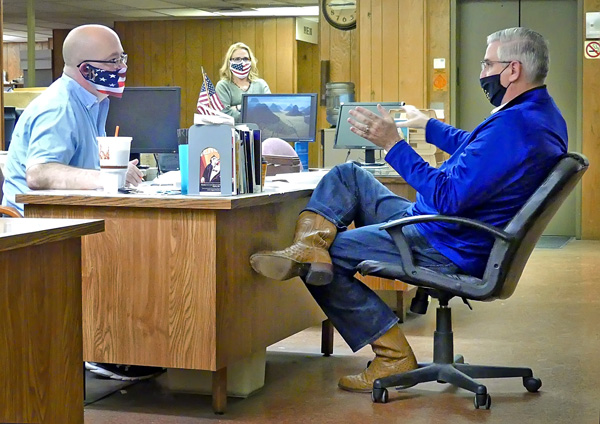
People are coming to Indiana for economic opportunities, according to Indiana Gov. Eric Holcomb.
Holcomb stopped by the Times-Union Friday afternoon between visits to Kokomo and Elkhart to talk about the state’s economy, COVID-19 and other issues.
“We get a lot of phone calls on how we’re able to balance lives, first and foremost, and our livelihood. That’s what it is every day. We had a flu playbook, but, certainly, nothing of this scale and pace that it’s ravaging around the world,” he said. “Having said that, I’m more than inspired on a daily basis by the number of people that are just making adjustments, figuring out ways to, again, No. 1 care for those who are in need, but 2, do business and change their former routines but still carry on.”
He said the economy is responding to that.
“And that’s what I don’t want folks to lose sight of. It’s not that I’m glossing over or simply this eternal optimist … but there is an awful lot going on in the state of Indiana in terms of this year, 2020,” Holcomb said.
As of about a week ago, the state has done 233 different new job commitment projects. “It’s about a new deal every three days this year, going through a global pandemic,” he said.
“We’re north of 26,000 jobs. An average of over $27 an hour. Then you say, ‘What does that mean to me, this $5 billion Cap X (capital expenditures) that’s occurring?’ Well, this isn’t happening in a lot of states around the country. And you’re starting to see Indiana as this in-migration state, even during a global pandemic. People are making long-term decisions,” Holcomb said.
The latest numbers, as of Friday from the Indiana Economic Development Corporation (IEDC), provided by Holcomb’s office, show the state has done 238 projects, with 26,439 new jobs at an average hourly wage of $27.92 for a capital investment of $4.840 billion.
In 2016, the state had 20,320 new job commitments compared to this year at already 26,439 new job commitments. And there’s two months left to go.
In the northeast quadrant of Indiana, Holcomb said, “There’s been $335 million of Cap X, a week ago, and we’re doing more; 2,500 new job commitments that average this $27 an hour or more. So our job is to make sure we’re replacing any jobs that are lost, helping people bridge to the other side of this COVID-19, and as we get closer to therapeutics and a vaccine … we have to make sure that we’re caring for those folks who are either hospitalized or have been wiped out because of COVID-19.”
The hospitality industry in Indiana is a strength for the state as it is elsewhere. “But we have to deal with reality. And until we get to that point to where we’re on the other side of this, we’ve got to take some personal responsibility and mask up, physically distance when you can’t mask up, personal hygiene. Do those – what seem to be really small things in the whole scheme of life, just like wearing a seatbelt or wearing shoes into a restaurant,” he said. “These are small things that we can and should be doing and that’s going to help us control what we can’t control.”
COVID fatigue has set in with a lot of people. They don’t want to wear their masks or participate in contact tracing.
“About 25% of folks that we’re reaching out to and contacting, it’s for different reasons. You’ve got your group that just wants to be left alone, they don’t want to deal with reality – it’s kind of tough love: don’t want to hear it, don’t want to go there,” Holcomb said. “Then you’ve got some folks who say, ‘Look, easier said then done. If I have to drop out of what I’m doing, my routine, that means I’ve got to stay home … and I can’t leave my job.’ So there’s an understanding from everyone, but the more people that practice best practices, that’s going to obviously alleviate some of the stress and load on our hospitals and our frontline health care workers who are stressed as well.”
On Friday, a news release from the Indiana State Department of Health announced that 3,205 additional Hoosiers were diagnosed with COVID-19 through testing at state and private laboratories. Friday’s results stem from a record 41,181 tests reported to the state in the preceeding 24 hours.
“Globally, by the way, and I’m not trying to make an excuse, or say that we’re no different, but at the outset in late March, we were doing about 1,500 tests a day. And now we’re consistently doing 31,000-41,000. So when you see a number like 3,200 positive cases as was reported out yesterday, we are reaching out further. So there’s some good news in there as well,” he said. “That means contact tracing is working more. People are, even though they are asymptomatic, they’re getting tested because they can. There is the capacity to test. And we need to know. That’s our radar, that’s why we’re testing. You test, you trace and then you isolate the folks who are positive.”
That’s how the virus is contained, allowing businesses to stay open and kids in school. He said they’ll continue to monitor the situation and not go to one extreme or the other.
“I’m trying to hit it right down the fairway, balancing both our lives and livelihoods, because when you do shut down, just blanket shutdown, that has some adverse ripple effects as well. And not just economically. To our psyche, to our psychological well-being quite frankly,” Holcomb said.
Holcomb said dealing with all the COVID-19 issues requires a partnership between the state, communities, cities, counties and schools.
“I’ve always been a proud Hoosier, but I’m more proud today and I will be prouder tomorrow, I’m sure, just seeing schools and businesses, individuals, families respond the way they have and their generosity,” Holcomb said.
He also mentioned how the need for broadband internet across the state became more obvious this year with schools going to eLearning during the pandemic.
“In a state like Indiana that’s 80%-plus farm or forest terrain and has a lot of rural areas that aren’t connected via affordable high-speed internet access, we needed to make up some ground. So we got creative and we found a way to devote $100 million that would be leveraged with the private sector. We said we’ll go there if you will,” he said.
“We figured out a different way to leverage and bring in the private sector,” Holcomb said. “We still have a long way to go. This is north of a $100 billion national need, and then you just look at Indiana – one state in the middle of it all – and how are we solving this? It requires our corporate sector, for sure. It requires the USDA, for sure, we’re making some progress there as well. It certainly requires the state of Indiana to say, ‘How can we all, in all 92 counties … make the equation add up for the individual family?’ And that’s why we leaned into, with another $61 million to schools … in response to what the schools were telling us directly. Going into a budget year that’s going to be tight, tight, tight, this is still a major priority and it’s been highlighted because of COVID-19, but it hasn’t surfaced because of COVID-19. It was a priority prior.”
Holcomb said they track not only business investment, but also people who are moving to Indiana.
“They’re going online and they’re looking at property values, home values, and they’re saying, ‘Where’s a good school corporation? Where’s a good hospital? What’s the property values in that area?’ And they’re moving from some neighboring states to ours. So all of these amenities – down to the trails, down to the city park – they all add up in terms of quality of place and broadband internet is just another example of something that parents, when they move (consider) because what COVID-19 has done is it’s redefined quality of place,” Holcomb explained.
The pandemic has proven that people can work from home, and instead of paying higher taxes and mortgages in another state for a job, they can do the same work in Indiana with a lower mortgage and property taxes and be able to send their children to schools like Warsaw, he said.
“We’re seeing people literally move to the state of Indiana, and it’s because of a lot of work that’s gone in to make this state very attractive from a local and state perspective, working in unison and harmoniously on the toughest of problems, whether it’s the internet or the budget or health in general,” he said.
Schools today are trying to teach students skills for careers that don’t even exist yet.
“These 27,000 open jobs, these are only the jobs that came through the IEDC. There’s another, if you go on IndianaCareerConnect.com, 109,817 unfilled jobs right now that you can see in every single county in the state. All 92 counties. Those are created on their own we had nothing to do with,” Holcomb said. “And so, where are all of those jobs, and how do we connect the people who are looking with the skill set that they need to fill those jobs that are there and/or these 27,000 through the IEDC.”
He said it has to be systemically addressed through the K-12 pipeline. “Teaching more computer science, a big effort in the state of Indiana. We’re one of the few states actually in the country that are insisting on that, to offer computer science in all of our schools. And that is in preparation for the basic skill sets you need to learn how to learn,” he said.
Holcomb said the state is leaning in heavy to that K-12 pipeline and “how we skill up. That’s where the Next Level Jobs program comes really into focus with post-secondary education and training.”
He said northeast Indiana has been a real role model on that front.
“The programs that we have in our high schools (exist) so there’s a seamless transition from whether you to go to college or you go right into a career through earn and learn, through apprenticeships or you go into the military. Making sure you that you’ve got this pathway, you’ve been not just exploring it, you’ve been engaging and connecting,” Holcomb said.
He wants every student in Indiana to have those options, and there are options in the state. The trick is, he said, “How do we get you connected with what you’re passionate about, because there is a diversly of pursuits? How do we get you connected and say, ‘Here’s your ticket to success, but it requires you to go to this credential’?
“… It’s making sure we’re connecting the person with the skill sets and the job and helping that occur,” he said.




